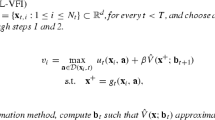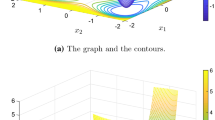Abstract
This paper describes the implementation of power series dual affine scaling variants of Karmarkar's algorithm for linear programming. Based on a continuous version of Karmarkar's algorithm, two variants resulting from first and second order approximations of the continuous trajectory are implemented and tested. Linear programs are expressed in an inequality form, which allows for the inexact computation of the algorithm's direction of improvement, resulting in a significant computational advantage. Implementation issues particular to this family of algorithms, such as treatment of dense columns, are discussed. The code is tested on several standard linear programming problems and compares favorably with the simplex codeMinos 4.0.
Similar content being viewed by others
References
I. Adler, N. Karmarkar, M.G.C. Resende and G. Veiga, “Data structures and programming techniques for the implementation of Karmarkar's algorithm,”ORSA Journal on Computing 1(2) (1989).
I. Adler and R.C. Monteiro, “Limiting behaviour of the affine-scaling continuous trajectories for linear programming problems,” Report ESRC 88-9, Engineering Systems Research Center, University of California (Berkeley, CA, 1988).
A.I. Ali and J.L. Kennington, “Mnetgn program documentation,” Technical Report IEOR 77003, Department of Industrial Engineering and Operations Research, Southern Methodist University (Dallas, TX, 1977).
J. Aronson, R. Barr, R. Helgason, J. Kennington, A. Loh and H. Zaki, “The projective transformation algorithm by Karmarkar: A computational experiment with assignment problems,” Technical Report 85-OR-3, Department of Operations Research, Southern Methodist University (Dallas, TX, August 1985).
E.R. Barnes, “A variation on Karmarkar's algorithm for solving linear programming problems,”Mathematical Programming 36 (1986) 174–182.
D.A. Bayer and J.C. Lagarias, “The nonlinear geometry of linear programming: I. Affine and projective rescaling trajectories,” to appear in Transactions of the AMS (1989).
M.L. de Carvalho, “On the work needed to factor a symmetric positive definite matrix,” Technical Report ORC 87-14, Operations Research Center, University of California (Berkeley, CA, 1987).
V. Chandru and B.S. Kochar, “A class of algorithms for linear programming,” Research Memorandum 85-14, School of industrial Engineering, Purdue University (West Lafayette, IN, 1986).
I.I. Dikin, “Iterative solution of problems of linear and quadratic programming,”Soviet Mathematics Doklady 8 (1967) 674–675.
J.J. Dongarra and E. Grosse, “Distribution of mathematical software via electronic mail,”Communications of the ACM 30 (1987) 403–414.
I.S. Duff, A.M. Erisman and J.K. Reid,Direct Methods for Sparse Matrices (Claredon Press, Oxford, 1986).
S.C. Eisenstat, M.C. Gurshy, M.H. Schultz and A.H. Sherman, “The Yale sparse matrix package, I. The symmetric codes,”International Journal of Numerical Methods in Engineering 18 (1982) 1145–1151.
D.M. Gay, “Electronic mail distribution of linear programming test problems,”Mathematical Programming Society Committee on Algorithms Newsletter 13 (December 1985) 10–12.
D.M. Gay, “Electronic mail distribution of linear programming test problems,” Numerical Analysis Manuscript 86-0, AT&T Bell Laboratories (Murray Hill, NJ, 1986).
P.E. Gill, W. Murray, M.A. Saunders, J.A. Tomlin and M.H. Wright, “On projected Newton barrier methods for linear programming and an equivalence to Karmarkar's projective method,”Mathematical Programming 36 (1986) 183–209.
C. Gonzaga, “Interior point algorithms for linear programming problems with inequality constraints,” Report ES-140/88, COPPE-Federal University of Rio de Janeiro (Rio de Janeiro, Brazil, 1988).
J.K. Ho and E. Loute, “A set of staircase linear programming test problems,”Mathematical Programming 20 (1981) 245–250.
J.H. Hooker, “Karmarkar's linear programming algorithm,”Interfaces 16 (1986) 75–90.
K.N. Johnson, “Forplan version 1: An overview,” Technical Report, Land Management Planning-System Section, USDA, Forest Service (Fort Collins, CO, 1986).
N. Karmarkar, “A new polynomial-time algorithm for linear programming,”Combinatorica 4 (1984) 373–395.
N. Karmarkar, J. Lagarias, L. Slutsman and P. Wang, “Power series variants of Karmarkar type algorithms,” Technical Report, AT&T Bell Laboratories (Murray Hill, NJ, 1989).
J. Kennington, “A primal partitioning code for solving multicommodity flow problems (version 1),” Technical Report 79008, Department of Industrial Engineering and Operations Research, Southern Methodist University (Dallas, TX, 1979).
I.J. Lustig, “A practical approach to Karmarkar's algorithm,” Technical Report SOL 85-5, Systems Optimization Laboratory, Stanford University (Stanford, CA, 1985).
N. Megiddo and M. Shub, “Boundary behavior of interior point algorithms for linear programming,” IBM Research Report RJ5319, Almadén Research Center (San Jose, CA, 1986).
B.A. Murtagh and M.A. Saunders, “Minos user's guide,” Technical Report 77-9, Systems Optimization Laboratory, Stanford University (Stanford, CA, 1977).
B.A. Murtagh and M.A. Saunders, “Minos 5.0 user's guide,” Technical Report 83-20, Systems Optimization Laboratory, Stanford University (Stanford, CA, 1983).
D.J. Rose, “A graph-theoretical study of the numerical solution of sparse positive definite systems of linear equations,” in: R.C. Read, ed.,Graph Theory and Computing (Academic Press, New York, 1972) pp. 183–217.
R.E. Tarjan,Data Structures and Network Algorithms (Society for Industrial and Applied Mathematics, Philadelphia, PA, 1983).
M.J. Todd and B.P. Burrell, “An extension of Karmarkar's algorithm for linear programming using dual variables,”Algorithmica 1 (1986) 409–424.
J.A. Tomlin, “An experimental approach to Karmarkar's projective method for linear programming,” Manuscript, Ketron, Inc. (Mountain View, CA, 1985).
K. Tone, “An implementation of a revised Karmarkar method,” Interim Report, Graduate School for Policy Science, Saitama University (Urawa, Saitama 338, Japan, 1986).
R.J. Vanderbei, M.J. Meketon and B.A. Freedman, “A modification of Karmarkar's linear programming algorithm,”Algorithmica 1 (1986) 395–407.
M. Yannakakis, “Computing the minimum fill-in is NP-complete,”SIAM Journal on Algebraic and Discrete Methods 2 (1981) 77–79.
Author information
Authors and Affiliations
Rights and permissions
About this article
Cite this article
Adler, I., Resende, M.G.C., Veiga, G. et al. An implementation of Karmarkar's algorithm for linear programming. Mathematical Programming 44, 297–335 (1989). https://doi.org/10.1007/BF01587095
Received:
Revised:
Issue Date:
DOI: https://doi.org/10.1007/BF01587095




